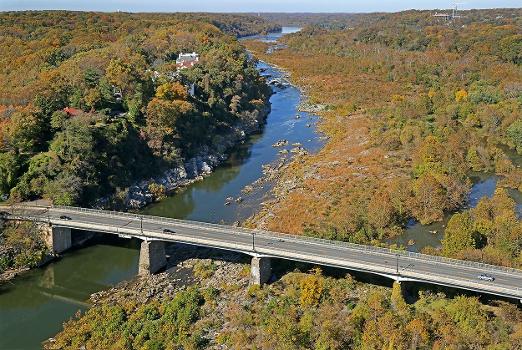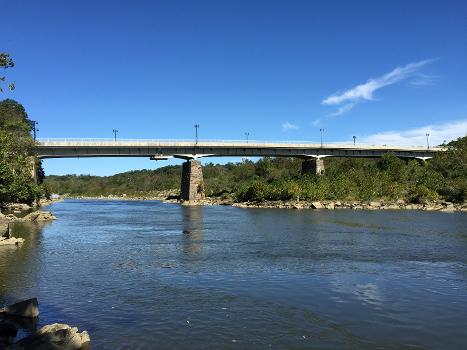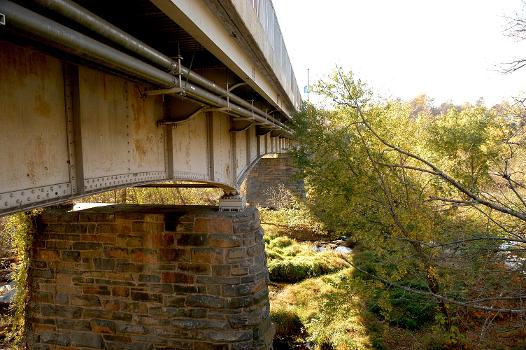General Information
| Completion: | 17 June 1938 |
|---|---|
| Status: | in use |
Project Type
| Structure: |
Twin girder bridge |
|---|---|
| Function / usage: |
Road bridge |
| Material: |
Steel bridge |
| Structure: |
Haunched girder bridge |
| Support conditions: |
for registered users |
| Plan view: |
Structurae Plus/Pro - Subscribe Now! |
| Material: |
Structurae Plus/Pro - Subscribe Now! |
Location
| Location: |
Washington, District of Columbia, USA Virginia, USA |
|---|---|
| Crosses: |
|
| Coordinates: | 38° 55' 46.97" N 77° 6' 55.93" W |
Technical Information
Materials
| piers |
masonry
|
|---|---|
| girders |
steel
|
Excerpt from Wikipedia
The Chain Bridge is a viaduct which crosses the Potomac River at Little Falls in Washington, D.C. It carries close to 22,000 cars a day. It connects Washington with affluent sections of Arlington and Fairfax counties in Virginia. On the Washington side, the bridge connects with Canal Road. Left turns onto the Clara Barton Parkway from the Chain Bridge are prohibited, but the reverse is permitted. On the Virginia side, the bridge connects with State Route 123 (Chain Bridge Road), which provides access to the George Washington Memorial Parkway.
The Chain Bridge has three lanes (of which the center is reversible) and can be safely accessed by pedestrians and cyclists. The pedestrian sidewalk provides access to the Chesapeake and Ohio Canal towpath via a ramp.
History
The first bridge at the location was opened on July 3, 1797. It was a wooden covered bridge, and rotted and collapsed in 1804. The second bridge, of similar type, burned six months after it was built.
The third bridge was built four years later in 1808, and is where the bridge received its name. It was a chain suspension bridge, using 1¼ inch bars. It was designed by Judge James E. Finley, and was 136 feet long by 15 feet wide. It was destroyed by flood in 1810 or 1812. The fourth bridge was also a chain suspension bridge, and though damaged by floods in 1815, it lasted until 1840. The fifth bridge was built in 1840, and made of chain and wood. This span collapsed in 1852.
It was replaced by a crossbeam truss structure that resembled a long garden arbor or pergola, but retained its historical name. During the American Civil War, the Chain Bridge was a popular place for the Union Army to access the countryside encampments from Fairfax County. The bridge is the site of the first Union Army Balloon Corps balloon crossing, which took place overnight on October 12, 1861, conducted by Professor Thaddeus S. C. Lowe and a band of handlers who had to precariously traverse the outsides of the fully trellised bridge. In a nine-hour ordeal, the balloon Union was fully inflated in Washington and walked out to the battlefield at Lewinsville, Virginia.
The truss bridge was swept away in an 1870 flood, and a lightweight iron truss replacement was erected in 1872-1874. Traffic restrictions were placed on the bridge in the 1920s, and it was fully closed following the record flood of 1936.
The eighth and present version of the bridge is a continuous steel girder structure, completed in 1939 on piers dating from the 1870s.
Text imported from Wikipedia article "Chain Bridge (Potomac River)" and modified on July 23, 2019 according to the CC-BY-SA 4.0 International license.
Participants
Currently there is no information available about persons or companies having participated in this project.
Relevant Web Sites
- About this
data sheet - Structure-ID
20023257 - Published on:
03/10/2006 - Last updated on:
06/02/2023










